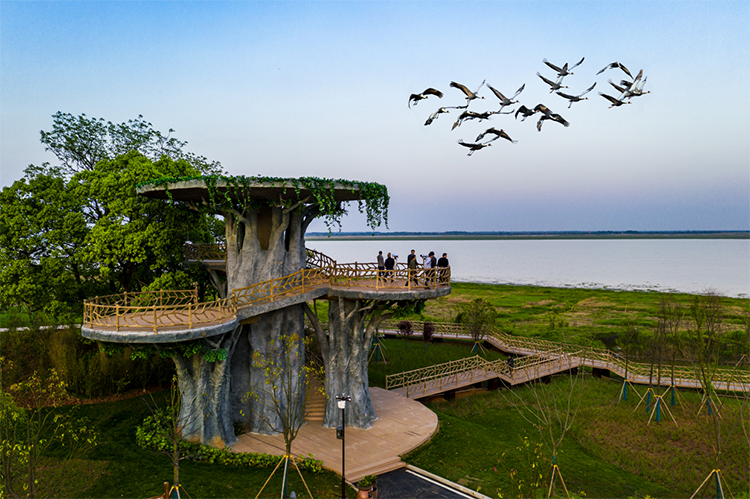Wucheng Birdwatching Tours: Visit the Winter Home of the World’s Cranes
Introduction
When the golden light of sunset spills across Poyang Lake and tens of thousands of white cranes wheel above the reed beds, the ancient bluestone streets mirror the eaves of Ming and Qing guildhalls—this is Wucheng Bird Town, an ecological secret where time seems to pause. A world-class wetland fused with a thousand-year trading town, Wucheng evokes the Tang-poem scene of “sunset and solitary birds” while hosting the planet’s largest wintering population of white cranes.
1. World Migratory Birds’ Last Stop
On the East Asian–Australasian migratory flyway, the Wucheng wetlands shine like a green gem. From late October through March, the area gathers about 98% of the world’s white cranes, 70% of Oriental storks, and more than 300 species including geese and small swans. In the shallow margins of the lakes at dawn you can witness a spectacle: tens of thousands of birds taking flight in the mist, wings creating a natural symphony. The best viewing platform is the second level of Birdwatching Tower No. 3.
Ecological photographer Wang Jianjun recalls, “When water levels fall in late November, the lake forms shallow sandbars and you get ‘waves of birds’—2000 cranes feeding in unison. Even shutter sounds feel unnecessary.” The reserve has a 6-kilometer ecological boardwalk and eight camouflaged observation huts where visitors can watch preening, courtship, and other natural behaviors up close.
2. An Ancient Town Floating Between History and Water
Pass through the modern birding zones and you’ll suddenly step into northern Jiangxi’s final “waterborne Scroll of Riverside Scenes.” Founded in 202 AD, Wucheng prospered for five centuries as a major trading port. Today 1,800 meters of lakeside ancient street remain, where Huizhou-style sealed firewalls sit beside Western arched windows—testimony to a multicultural past shaped by tea guilds and salt merchants.
Three unmissable historic sites:
– Ji’an Guildhall: Built by merchants from Luling during the Qing dynasty. The carved wooden caisson ceiling features a hidden motif of “a hundred birds paying homage to the phoenix,” depicting 32 real migratory bird species.
– Wanghu Pavilion: The three-tiered pavilion where Song statesman Wang Anshi once penned verses; a superb vantage point to photograph the meeting of rivers and lakes.
– The Water Highway: During the flood season (June–August) the 5-kilometer Yongwu Road is submerged, creating the surreal image of vehicles traveling across shimmering water.

3. A Wetland Painted by the Four Seasons
This internationally important wetland is nature’s palette: in spring the reeds turn fresh green as cranes dance courtship rituals; in summer the lotus boardwalk becomes a corridor of fireflies; in autumn and winter the silver reed plumes fall like snow and form a seasonal love song with the birds. The park practices an “ecological rotation” system, adjusting open areas monthly to protect bird habitats while maintaining visitor experience.
A veteran guide recommends: “The second week of December is usually the golden window for birding. The ‘bird-wave breakfast’ between 6:30–8:00 a.m. is most dramatic. Bring a telephoto lens of 200mm or longer—professional spotting scopes are also available for rent.”
4. Immersive Eco Experiences: Practical Guide
Transportation
Drive from Nanchang Changbei Airport via Yongwu Expressway in about 1.5 hours, or take high-speed rail to Yongxiu Station and transfer to the hourly tourist shuttle. The park operates electric shuttle buses; private cars are not allowed into the core zones.
Activities
– Families: Wetland Museum 4D theater + daily bird rubber-stamp DIY at 10:00 and 14:00.
– Deep Experience: Join bird rangers for banding and field research (reserve at least one week in advance).
– Hidden Trails: An 8-kilometer lakeside ancient courier road links Ming-dynasty boundary stones with wild wetlands.
Food & Accommodation
The town’s “White Crane Guesthouse” serves Poyang Lake’s three freshwater delicacies (silverfish, wild sesame greens, eel). Near the birding platforms, container hotels offer underfloor heating—open the curtains to see cranes roosting at dusk.

Practical Information
– Opening season: November 1–March 31, daily 6:30–17:30 (extended to 18:00 during peak birding season).
– Admission: 120 RMB per person, including park shuttle; teachers and students receive half price with valid ID.
– Notes: Drones must be registered in advance; some areas close during red weather alerts.
When the last crane departs northward, Wucheng often sees a last snowfall of reed fluff—the town’s quiet farewell to the birds. Here, people learn to take the supporting role and watch the planet’s true residents perform a timeless saga of survival and fidelity. Pack your binoculars: a natural epic about promise and endurance unfolds on Poyang Lake each year.


